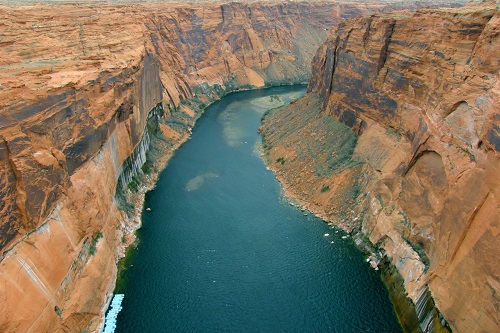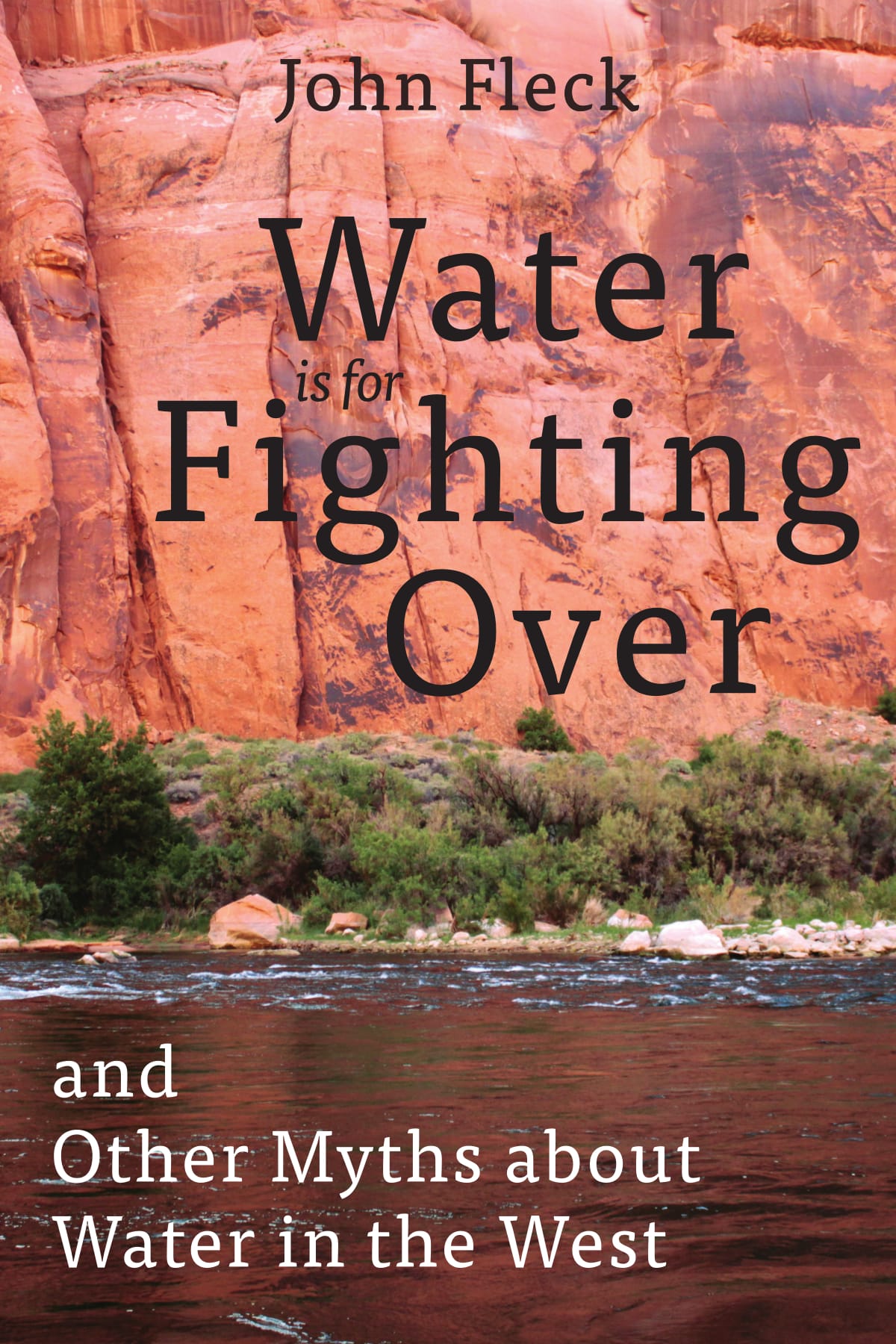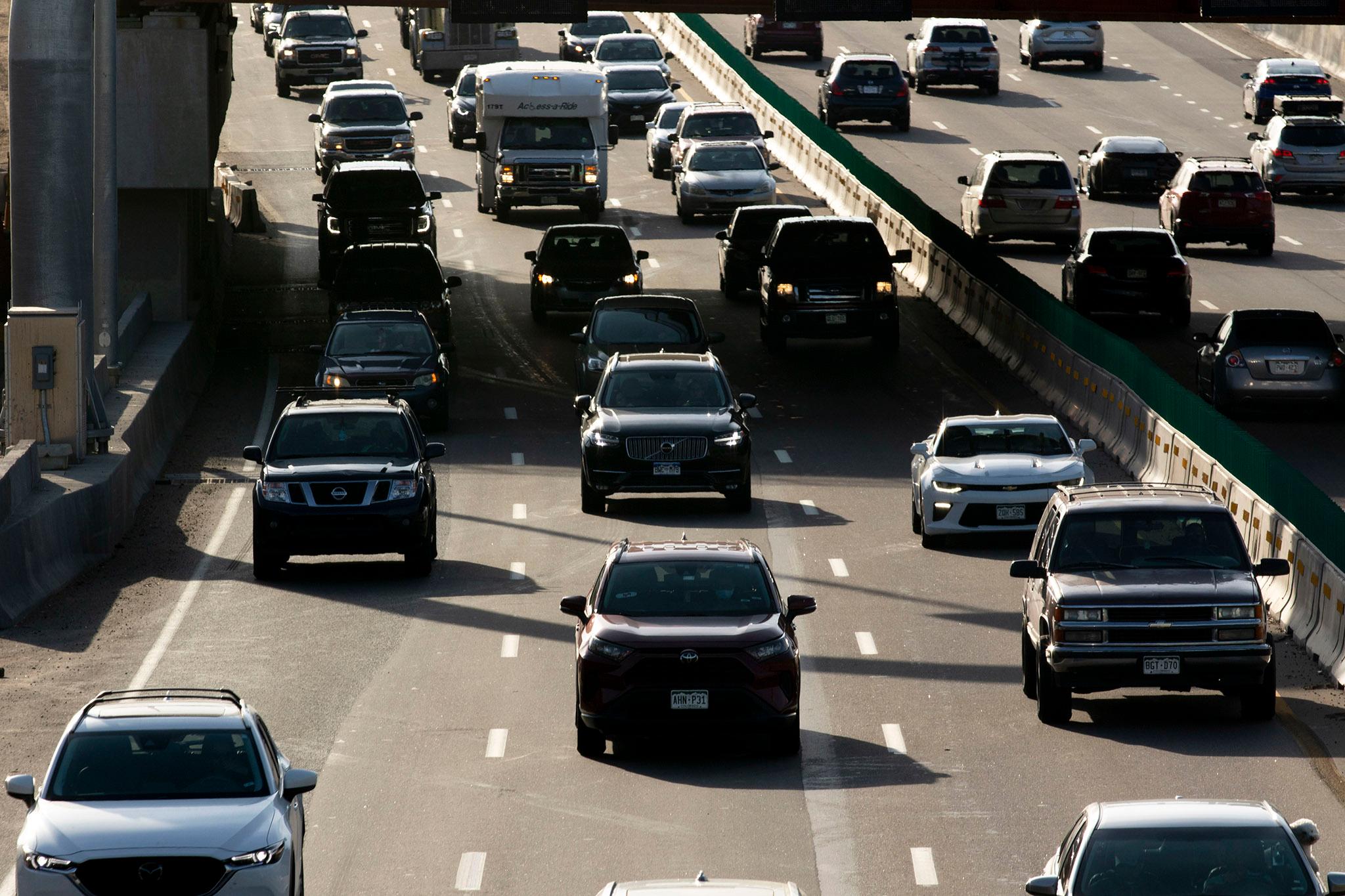

In the next few years, the federal government could force Arizona and Nevada to use less water from the Colorado River. It would be required if Lake Mead is below 1,075 feet on January 1 of any given year, and while it is unlikely in 2017, it is a distinct possibility in 2018, according to John Fleck, director of the Water Resources Program at the University of New Mexico.
To avoid federally mandated cutbacks, Arizona, Nevada and California are working together to come up with savings, to account for the fact that climate change and population growth in the region are stressing the river more than ever before.
Fleck says that's encouraging, because when states work together they have a better chance of putting the limited water on the Colorado River to good use. But cooperation is a departure for this river basin, Fleck says, which for a long time has lived by the saying, "Water is for fighting over."
That's just one old saw that Fleck wants to dispel with his new book, "Water is for Fighting Over, and Other Myths About Water In the West." Fleck previously worked for 25 years as a journalist at the Albuquerque Journal, covering water and other topics. He spoke with Colorado Matters host Ryan Warner.
Other myths Fleck takes on in his book: Water flows uphill towards money; the West is about to run out of water; prior appropriation stands in the way of a solution to the West's water shortages; and crops like alfalfa should be banned in water-starved states.
Related:
- Colorado River Planners Eye New Playbook As Climate Change, Drought Squeeze Supply
- Water Policies Are 'Killing The Colorado,' ProPublica Finds
- Get Rid Of The U.S. Bureau Of Reclamation, Says Its Former Boss
Read an excerpt:
CHAPTER 1: REJOINING THE SEA Standing in the dry bed of the Colorado River at San Luis in the Mexican state of Sonora, just south of the Arizona border, Manuel Campa was insistent. The Mexican border city, perched on a low mesa to the east, is not just “San Luis.” It is “San Luis Río Colorado.” “It’s the only city that has the name ‘Rio Colorado,’” Campa, technical director of the city’s water utility, told me as we strolled the river’s sandy bottom on a warm spring morning. It took imagination to grasp what Campa was getting at. Nineteenth-century steamboats once passed this spot. The Colorado was once a river here. No more. The only thing capable of navigating the Rio Colorado’s bed that day was a four-wheeler with fat tires. Tamarisk, a scrappy invasive shrub, had long ago replaced native cottonwoods and willows along the river channel. Water-loving beavers, once common, seemed a comic impossibility. Over the last century, we have taken the river’s water, moving it through dams and canals to grow a hydraulic empire of farms and cities across the semi-arid Colorado River Basin. By the time the Colorado River approaches its feeble desert end, most of its water has been diverted to Denver, Albuquerque, Phoenix, Las Vegas, Los Angeles, Mexicali, and vast farmlands in between. Morelos Dam, twenty-two miles upstream from San Luis, diverts Mexico’s share of the water—the last of the river—to the rich, productive farmland of the Mexicali Valley and cities to the west. The first time I saw this, I was stunned. Driving the Yuma County levee past Morelos Dam in 2010, I saw the last trickles of water from leaks in the dam and a shallow water table disappear within a few miles into a sandy, dry channel. This great river, the Colorado, around which I have spent much of my life, whose water I have showered with and drunk, which has grown the food I eat and floated my boats for hundreds of miles, simply disappears into the desert sand. But that spring day in 2014, Campa and I were awaiting something remarkable. In the midst of fourteen years of drought, with reservoirs dropping upstream and fears of water shortage gripping the Colorado River Basin, water managers were creating a modest “pulse flow,” meant to mimic a natural spring flood through the desiccated delta. It was a test of how much water would be needed for native plant to come back to life and repopulate the area. But as the water arrived a San Luis, and for the weeks after, it became something more. The usually dry riverbed past the town turned into a fiesta as children who had never seen water here frolicked in a briefly flowing Rio Colorado. And at another, deeper level, it demonstrated unprecedented international cooperation to achieve a goal once thought impossible. Chinatown As California burned through the summer of 2015, its fourth year of drought, geographer Daniel Grant described the myriad photos of cracked reservoir mud and dried irrigation ditches and their accompanying headlines as part of a "genre of apocalyptic prophecy” that functions, according to Grant, “by diagnosing a human misalignment with nature, and foresees a future in which nature—as a kind of secular deity—punishes our errant behavior.” For much of my professional life as a writer, chronicling our uneasy existence in this arid place, I embraced this narrative. When I wrote stories about drought for the Albuquerque Journal, we had an office joke about “the obligatory cracked mud photo.” The paper’s photographers and I would hover over stream-gauge data to find the driest stretch of New Mexico’s rivers, and it was always a bonus if they came back with an image that included a dead fish to punctuate the message. These stories resonate, dominating our understanding of life in the arid West. Thus it is that the classic movie Chinatown has come to stand in for the history of Los Angeles water. It is a tale of villains bent on profit, messing with nature, and ultimately punished for their sins. To many, Chinatown represents water management in LA, despite historians’ best efforts to remind us that it was just a movie, that things didn’t really happen that way. The apocalyptic vision isn't limited to fiction. James Lawrence Powell, in his 2011 Colorado River history Dead Pool, predicts a Grapes of Wrath–like exodus from Phoenix. Perhaps no work is more important to the West’s narrative of crisis than journalist Marc Reisner’s epic Cadillac Desert, ominously subtitled The American West and Its Disappearing Water. Its core message, one commentator wrote later, was that the overbuilding of dams and overuse of water in the western United States would “catalyze an apocalyptic collapse of western US society.” Whether that is a fair characterization of Reisner’s work is an open question. Cadillac Desert has become shorthand for the water crisis, with all varieties of doom attributed to Reisner. In fact, Reisner concentrated his fierce critique on what he saw as a corrupt process that overbuilt the West’s great plumbing system. The subtitle notwithstanding, Cadillac Desert spends little time on the “disappearing water,” or the actual human consequences of water shortages. But neither did Reisner shy away from apocalyptic rhetoric. In the 1993 afterword to the book’s second edition, Reisner was explicit. California had just experienced what was at the time its worst drought on record, which, Reisner said, “ qualifies best as punishment meted out to an impudent culture by an indignant God.” Like many who manage, engineer, utilize, plan for, and write about western water today, I grew up with the expectation of catastrophe. I first wrote about water shortage in California during that same late-1980s–early-‘90s drought Reisner bemoans. But as drought set in again across the Colorado River Basin in the first decade of the twenty-first century, I was forced to grapple with a contradiction: despite what Reisner had taught me, people’s faucets were still running. Their farms were not drying up. No city was left abandoned. I began asking the same question, again and again: when the water runs short, who actually runs out? What does that look like? Far from the punishment of an indignant God, I found instead a remarkable adaptability. In Dona Ana County on the Rio Grande in southern New Mexico, I saw farmers idle alfalfa and cotton fields, crops that bring low returns for each gallon of water, shifting scarce supplies to keep high-dollar pecan orchards healthy and productive. As water supplies dropped to record lows, farmers continued to prosper. New Mexico’s cities fared just as well. In the midst of the drought, Albuquerque cut its per capita water use nearly in half, and the great aquifer beneath the city actually began rising as a result of a shift in supply and reduced demands. Across the Colorado River Basin, I found the same story over and over, from the fountains of Las Vegas and Phoenix to the farms of Imperial and Yuma counties, to the sprawling coastal metropolis of LA. When people have less water, I realized, they use less water. In spite of the doomsday scenarios, westerners were coping, getting along with their business in the face of less water. Things might have been easier had we not made the mistakes Reisner so ably documented, but we did what we did and, as scarcity sets in, we are adjusting to the new realities. I have witnessed this resilience time and again as I travel the hydraulic landscape of the western United States. This book chronicles my attempt to understand and explain where that ability to adapt comes from, how it works, and how we can call on it to get us through the hard times ahead. The Myths The catastrophe narrative isn’t just inaccurate—it promotes myths that actually stand in the way of solving our problems. Most obvious is the myth that “water’s for fighting over.” The quote is wrongly attributed to Mark Twain, but it’s also just plain wrong. Fighting rarely solves water problems, and scholars have found that collaborative agreements are far more common than winner-take-all fights, whether in the courts or with guns. A corollary myth is that “water flows uphill toward money,” as if the rich will inevitably run roughshod over their neighbors in the coming water wars. But a century of water allocation law and policy shows this is simply false for the vast majority of the water in the United States. One need simply look at farming’s share of Colorado River water (some 70 to 80 percent) compared with its share of the economies of the US basin states (2 percent) to see the fallacy in that truism. The far-richer cities have far less water than their farming cousins. The most pervasive of the myths is that we are “about to run out of water.” I’ve heard it countless times, and it usually follows a predictable pattern. Today, we need this much water to support this many people and this much farming. As either grows, we’ll need more water, the narrative would suggest. When the “need” line crosses the supply line, we will “run out.” This ignores history, where again and again we have seen both city and farm communities adapt and continue to grow and prosper without using more water, often, in fact, using less. But that deeply held fear of “running out” of water feeds back into the first myths, triggering a limbic response to protect “our share” against others. And therein lies the risk. If everyone ignores their own adaptive capacity and simply fights for more, or even fights for the share they’ve got now in a shrinking system, we are led headlong into conflict, with dangerous results. If instead we recognize our ability to make do with less, and invest in institutions that facilitate water sharing, we can create systems for robust, flexible, and equitable water allocation. Only then can we preserve the West that we have all come to inhabit, know, and love. From Water is for Fighting Over by John Fleck; citations from original omitted. Copyright (c) 2016 by the author. Reproduced with permission of Island Press, Washington, DC. |









